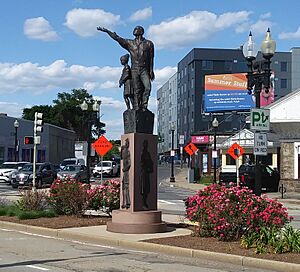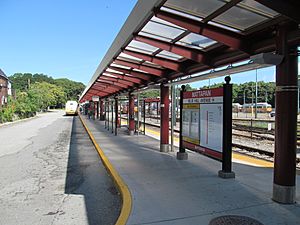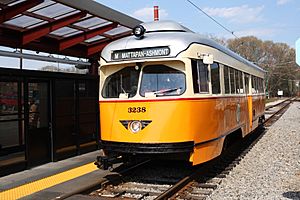Mattapan facts for kids
Quick facts for kids
Mattapan
|
|
|---|---|
|
Neighborhood of Boston officially a part of Dorchester.
|
|
 |
|
| Country | United States |
| State | Massachusetts |
| County | Suffolk |
| Neighborhood of | Boston |
| Annexed by Boston | Jan 6 1870 |
| Population
(2010)
|
36,480 |
| Time zone | UTC-5 (Eastern) |
| Zip Code |
02126
|
| Area code(s) | 617 / 857 |
Mattapan is a lively neighborhood in Boston, Massachusetts, in the United States. Its name comes from the Native American language of the Massachusett people. It might mean "a place to sit." In 2010, about 36,480 people lived there. Many residents are immigrants from different countries.
Mattapan grew a lot in the late 1800s and early 1900s. This happened as railroads and streetcars made it easier to get to downtown Boston. Most of Mattapan is residential, with different types of homes. You'll find public housing, small apartment buildings, and single-family houses. There are also many two- and three-family houses, often called triple-deckers.
The main shopping areas are along Blue Hill Avenue and at Mattapan Square. This is where Blue Hill Avenue, River Street, and Cummins Highway meet. Here, you can find banks, restaurants, and shops. The Mattapan Branch of the Boston Public Library opened in 2009. Mattapan also has lots of green spaces. These include Harambee Park, the Boston Nature Center and Wildlife Sanctuary, and the historic Forest Hills Cemetery. The neighborhood is home to many people from Haiti, other Caribbean islands, and African Americans. Mattapan has important public services, like a modern community health center. The Mattapan MBTA Station is the last stop on the Red Line Extension Trolley. You can reach it from Ashmont and other spots in Dorchester and Milton.
Contents
History of Mattapan
Early Inhabitants
Mattapan was first named and lived in by Native Americans. People have lived in eastern North America for at least 15,000 years. However, a huge ice sheet covered the area until about 11,700 years ago. This ice sheet would have made it hard for people to live in Mattapan.
The earliest confirmed settlements in Mattapan date back 2,000 years. Archaeologists have found signs of hunting, fishing, and gathering shellfish near the Neponset River. They also found places where stone tools were made in the Blue Hills.
The Massachusett Native Americans gave the name Mattapan to an area north of the Neponset River. It might mean "a sitting down place." This area was controlled by a leader named Chickatawbut. He was a sachem (chief) of the Neponset people when English explorers arrived in the early 1600s.
Native Americans often moved with the seasons. But their footpaths became the roads we use today in Mattapan. For example, Mattapan and Lower Mills were important river crossings. Today's Adams Street and River Street connected Mattapan to fishing spots.
European Settlement
English colonists settled Dorchester in 1630. In 1634, a record listed "Matampan" as the Massachusett name for Dorchester. Sadly, diseases like smallpox greatly harmed the Massachusett people in the early 1600s. Chickatawbut and many of his warriors died in 1633. After this, his brother, Cutshamekin, sold large parts of Massachusett land.
Later, Native Americans moved to special "praying towns." During King Philip's War, they were sometimes forced to live in certain places. This led to less Native American influence in Mattapan. However, later Massachusett leaders still owned and sold land in Dorchester.
Mattapan in the 20th Century
At the start of the 1900s, most people in Mattapan were Caucasian. But in the late 1960s, things began to change. Some real estate agents used unfair practices to make people leave the neighborhood. This caused many long-time residents to move out.
In the 1980s, many Haitians moved to Mattapan. This led to the diverse population we see today. Mattapan has become a very important place for Haitian culture in Massachusetts. By 2015, Mattapan also had many African Americans, Jamaicans, and other Caribbean immigrants.
During the 1960s and 1970s, Mattapan changed from being mostly Jewish to being largely African American and Caribbean American. Today, over 77% of its population of 37,486 is African American and Caribbean American.
Some people believe that banks and real estate agents caused this big change. They say these groups tried to lower property values to buy homes cheaply. Then, they would sell them at higher prices to Black families using special loans. This also encouraged white families to buy homes in the suburbs. Other historians argue that differences between Jewish and Catholic communities in Boston were a bigger reason for the changes. As Jewish people moved out, Caribbean Americans and African Americans moved in.
Who Lives in Mattapan?
Today, Mattapan is seeing another big change in its population. Many immigrants from Haiti and other Caribbean countries continue to move in. Mattapan now has the largest Haitian community in Massachusetts. It is also home to many African Americans and people from other Caribbean nations.
In 2013, Mattapan had 36,299 residents. About 82% were African American, 11% Caucasian, 1% Asian, and 2% mixed race. The rest were other races. Most people (72.4%) living in Mattapan were born in Massachusetts. About 23.6% were born outside the state, and 3.2% were born outside the United States. Of those born outside the U.S., 33.2% were from Haiti and 17.2% were from Jamaica.
For adults, about 38.9% have a high school diploma. About 14.7% have a bachelor's degree. The average household income in Mattapan is around $44,744 per year. There are about 12,345 people living per square mile.
Languages Spoken
Even though Mattapan has many different cultures, English is the main language. About 18.9% of the people speak French. This includes Creole languages. A small number (0.3%) speak Portuguese Creole.
The languages spoken at home also change with age. For example, about 68.2% of children aged 5–17 speak only English. But 16.9% of those children speak other European languages. Among young adults aged 18–24, 23.4% speak other European languages. About 63.9% of adults aged 18 to 24 speak English.
Homes in Mattapan
In 2010, the average cost to buy a home in Mattapan was $248,833. The neighborhood has many triple-decker apartments. The cost of living here is about 33% higher than the national average. Most people (64.3%) living in Mattapan rent their homes. The other 35.7% own their homes.
Getting Around Mattapan
The Mattapan Line is a light rail line run by the MBTA. It serves Mattapan, along with several bus routes. In 2016, there was a plan to change the Mattapan trolley into bus routes. This would have saved money. However, Boston officials fought against this idea. They argued that property values would drop, and it would harm a planned housing and shopping project near the Mattapan station. Because of this, the trolley will continue to run.
The Fairmount Line of the MBTA Commuter Rail also serves Mattapan. It has stations at Morton Street and Blue Hill Avenue. This line connects Mattapan to downtown Boston and nearby suburbs. The Fairmount Corridor Commuter Rail Line runs for about 9.2 miles. It has nine stations and serves only the city of Boston.
Green Spaces and Parks
Mattapan has some wonderful green spaces for everyone to enjoy:
- Harambee Park was built in 1898. It was designed by Frederick Law Olmsted, a famous American landscape architect. It was first called Franklin Field.
- The Franklin Park Zoo opened in 1912. It is considered a "jewel" of Frederick Law Olmsted's Emerald Necklace Park System.
- The Boston Nature Center and Wildlife Sanctuary is a hidden gem. It covers 67 acres in the Mattapan area. It is home to over 150 types of birds, 40 types of butterflies, and more than 350 types of plants. It also has the Clark-Cooper Community Garden. This garden provides fresh food and green spaces for over 250 local families. There are also two miles of trails through meadows and woodlands.
- The Forest Hills Cemetery is a beautiful example of a rural garden cemetery. It has important historical and cultural meaning for Boston. It was founded in 1848 to be a park-like place to bury and remember loved ones. It was added to the National Register of Historic Places in 2004.
Education in Mattapan
Schools for Kids
Boston Public Schools (BPS) runs the public schools in Mattapan. Some of the elementary schools include James J. Chittick, Mattahunt, and Charles H. Taylor. The Mildred Avenue K-8 School is also in Mattapan. The Young Achievers Science and Mathematics Pilot K-8 School is a BPS school. It is located where the Solomon Lewenberg Middle School used to be.
The Pope John Paul II Catholic Academy also has a campus in Mattapan Square. This used to be the Saint Angela Merci elementary school. All five public schools are part of the Boston Public School system. About 40% of male students and 33.9% of female students in Mattapan earn their high school diplomas.
Adult Learning
Mattapan has about 3,983 adults (12.2%) who have not finished high school.
Healthcare Services
The Mattapan Community Health Center is located on Blue Hill Avenue. It has been providing health services to Mattapan and Hyde Park for over 40 years. It is the only health center in the city. It is the main place for healthcare for residents. Its goal is to "improve the quality of life for residents of Mattapan and surrounding communities." It offers complete, easy-to-access, and affordable healthcare services. It is connected with Boston Medical Center and Brigham & Women's Hospital.
The Mattapan Adult Day Health Program started in 1980. It offers daily health services for seniors living in the Boston area.
Community Services
Libraries
The Boston Public Library operates the Mattapan Branch Library. In 1849, a Mattapan resident named Increase S. Smith started the Mattapan Library Association. In 1870, Dorchester, which included Mattapan, became part of Boston. The Mattapan branch began as a reading room. In 1923, it became an official branch of the Boston Public Library. The Mattapan Library Branch opened on Hazelton Street in 1931. The current library building opened on February 28, 2009, at 1350 Blue Hill Avenue.
Famous People from Mattapan
- Dana Barros – A former player in the NBA for the Boston Celtics and other teams.
- Leonard Bernstein – A famous conductor and composer.
- Big Shug – A rapper.
- Thomas M. Finneran – A Massachusetts politician.
- Nat Hentoff – A jazz critic and social commentator.
- Lillian B. Miller – An American art historian at the National Portrait Gallery, Smithsonian Institution.
- Bill Owens – A Massachusetts state politician.
- Theodore White – An author and political commentator.



